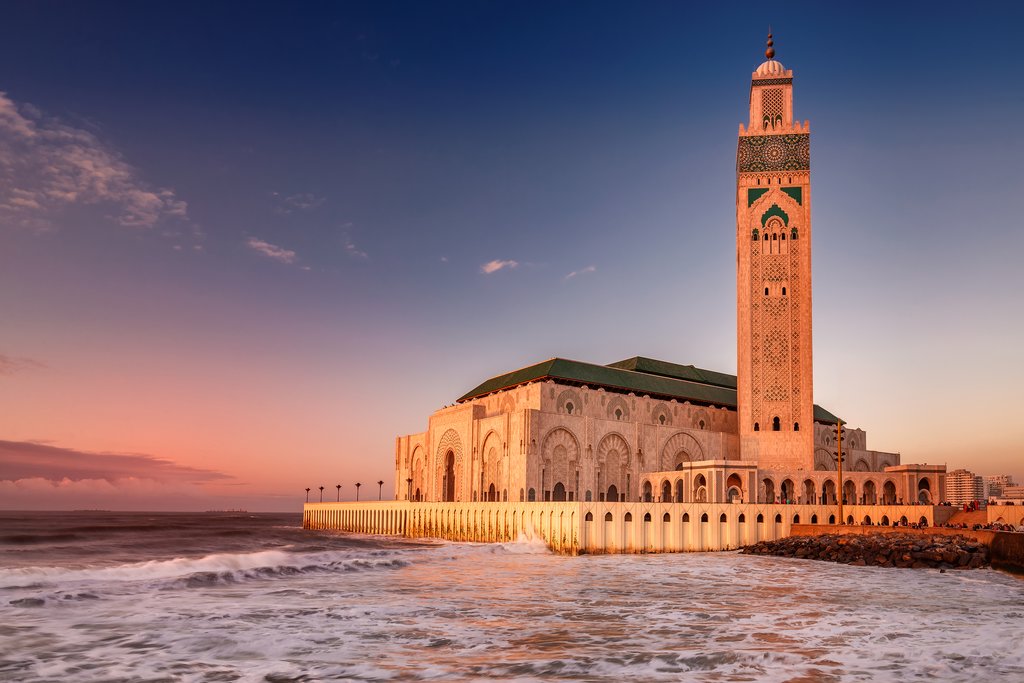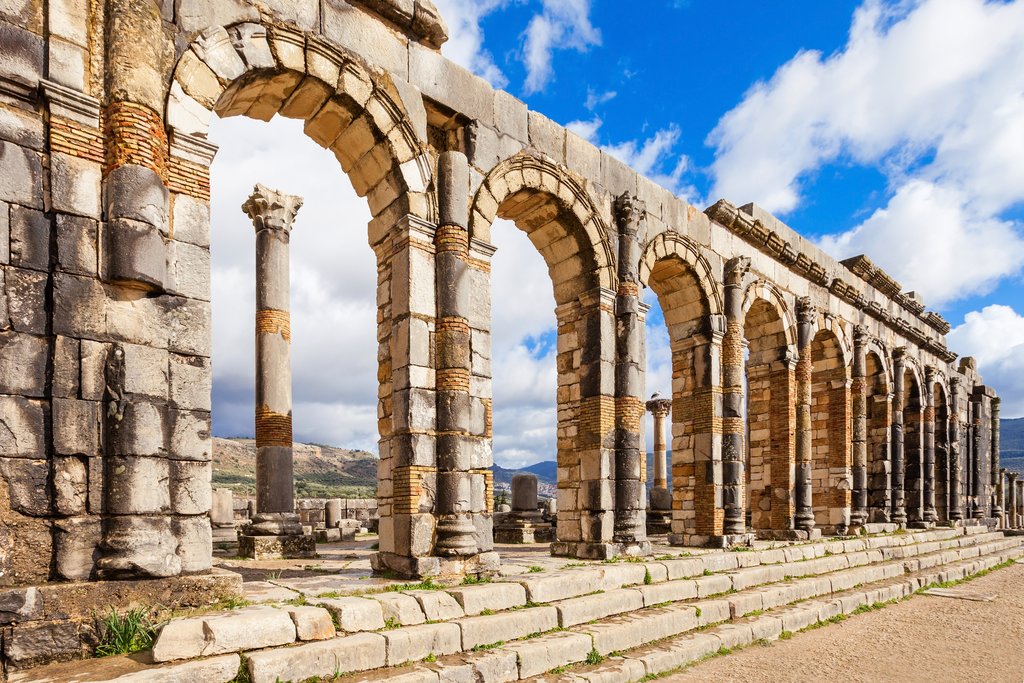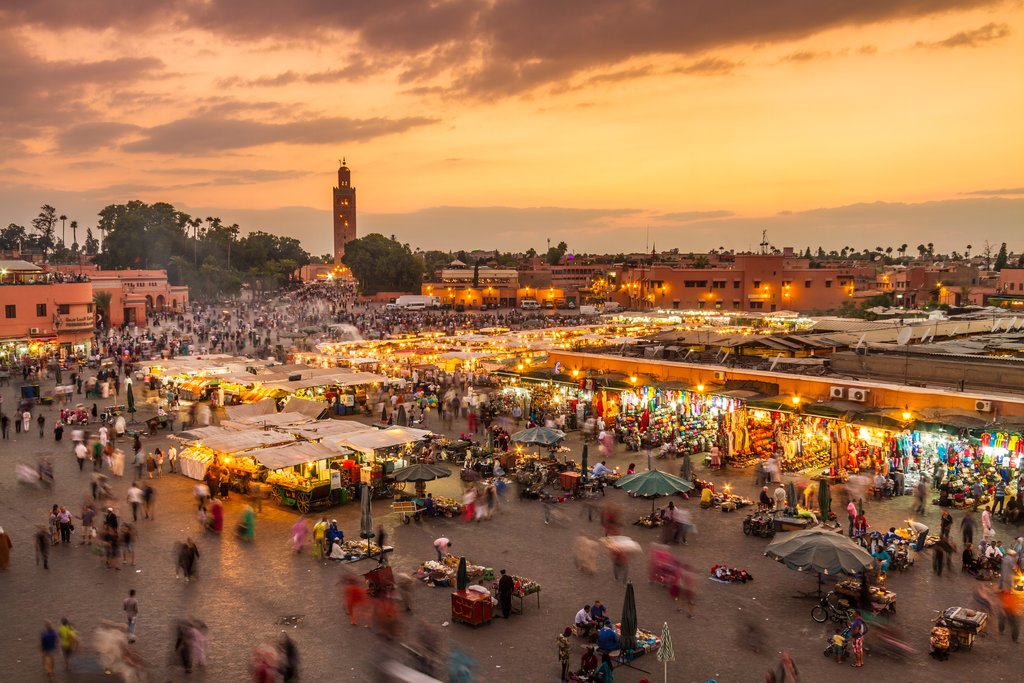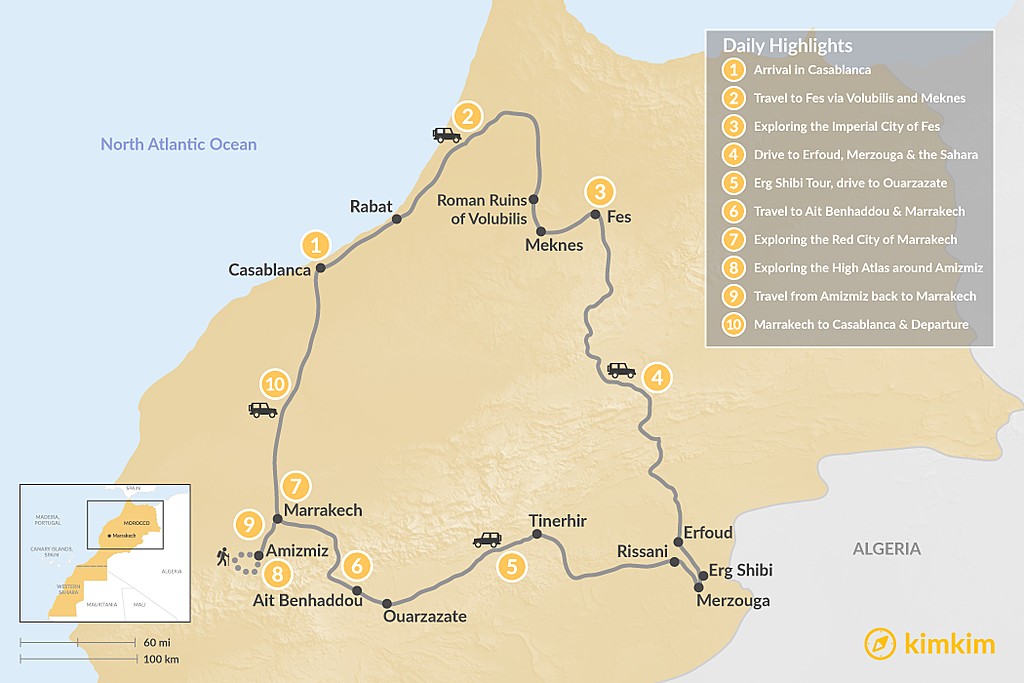Highlights
- Discover souks, tanneries, and artisan workshops in medieval Fes
- Explore sand dunes, oases, hidden valleys, and old kasbahs in the desert
- Hike through small villages in the foothills of the High Atlas mountains
- Share a meal and spend a night with a local Berber family
- Enjoy the evening spectacle of Jemaa el-Fna Square
Brief Itinerary
| Day | Highlights | Overnight |
|---|---|---|
| Day 1 | Arrive; Evening in Casablanca | Casablanca |
| Day 2 | Roman ruins at Volubilis and imperial cities of Meknes and Fes | Fes |
| Day 3 | Fes: Exploring the Imperial City and medieval Medina | Fes |
| Day 4 | Middle Atlas: Erfoud, Merzouga and the Sahara | Erg Chebbi |
| Day 5 | Desert towns, lush oases, and film worthy landscapes | Ouarzazate |
| Day 6 | Aït Benhaddou Kasbah and Tizi n'Tichka Pass over the High Atlas | Marrakech |
| Day 7 | Marrakech: Exploring the Red City | Marrakech |
| Day 8 | Amizmiz and the High Atlas mountains; Overnight in a Berber home | Amizmiz |
| Day 9 | Continue Hiking; Return to Marrakech | Marrakech |
| Day 10 | Return to Casablanca; Depart |
Detailed Itinerary
Day 1: Arrival to Casablanca

Welcome to the western coast of Morocco! Arrive in Casablanca and transfer to your hotel. Take a stroll along the Boulevard de la Corniche, the beach promenade that follows the Atlantic (often referred to as Morocco's Miami) to the Hassan II Mosque. Though tours of the interior are only offered in the morning, take advantage of the timing and watch the sunset behind the architectural marvel. Grab a bite in Rick's Café, a restaurant, bar, and café recreated to reflect the bar in the movie classic, Casablanca.
Day 2: Roman ruins at Volubilis and imperial cities of Meknes and Fes

Casablanca is a modern, commercial capital of Morocco, and is home to the stunning Hassan II Mosque. It sits on an outcrop over the Atlantic and has a 690 feet (210 m) minaret—the tallest structure in Morocco and the tallest minaret in the world! It is estimated the courtyard can hold 80,000 worshipers, with room for 25,000 inside. What makes this mosque unique is that it is one of the few mosques in the country non-Muslims can enter. Join a morning tour and admire the exquisitely ornate artisanship: hand-carved stone and wood, intricate marble floor detailing, and gilded cedar ceilings.
Continue to Meknes to explore the Ville Impériale (Imperial City). Roam gardens and palaces, the impressive gate of Bab al-Mansour and the Mausoleum of Moulay Ismail. Visit the nearby UNESCO-protected Roman ruins of Volubilis, a sprawling complex worth wandering. Marvel at the merchant homes, temples, and colorful mosaics in situ, including the Labors of Hercules. Carry on to Fes and navigate its impressively large and complicated medina (old quarter). Before venturing in, take a moment and visit the ruins of the Merenid Tombs to enjoy a panoramic view of the old city.
Spend the night in a beautiful riad in the old town where you can enjoy the local specialities.
Day 3: Fes: Exploring the Imperial City and medieval Medina

Fes is the oldest of the four Imperial Cities (Rabat and Marrakech are the other two) in Morocco and perhaps the most interesting and exciting to explore. It has the most complete medina in the Arab world and is relatively untouched since it was founded over 1000 years ago. Often considered the country's cultural capital, it is made up of three parts, two medina quarters, Fes el Bali and Fes el Jdid, and the more modern, French colonial influenced, Ville Nouvelle. Meet your guide and spend a half day learning about the history and culture as you navigate the narrow streets of the medinas.
Start in Fes el Bali at the Bab Boujeloud gate and enter the main thoroughfare of Talâa Kebira. Notice the Spanish and Tunisian influenced architecture as you make your way past shops and souks (markets). Visit the Chouara Tannery and marvel at the many dye-filled stone pots and the men at work still using centuries-old techniques. Next, admire the intricate zellij tilework of the 14th-century Al Attarine Madrasa before heading over to the Mellah (old Jewish quarter and cemetery) in Fes el Jdid. If there's time, visit Ville Nouvelle to discover the dramatic change in architecture.
Day 4: Over the Middle Atlas and into the Desert: Erfoud, Merzouga and the Sahara

Start your day bright and early and travel south toward Merzouga. Along the way, you will climb up and over the Col du Zad pass (7,146 feet or 2,178 m) through the cedar forests of the Middle Atlas mountains. Enjoy sightings of the local Barbary Macaque monkeys before stopping for lunch in Midelt (the 'apple city'), relishing the nearby Moulouya River. Continue over the Tizi n'Talremt pass and into the Ziz Valley, known for its hidden oases and palm tree clusters. Along the road, you will see many fortified houses known as ksars—built to protect precious wares, including gold, salt, and spices.
Continue on to Erfoud, known for its date festival and fossil mining. Here you can visit a local collective to learn more about the process and meet some local artisans. Continue to Erg Chebbi, an extensive sea of sand dunes covering an area of 13.5 square miles (35 square km). Never stationary, the massive dunes shift and travel depending on the changing wind. Upon reaching Merzouga, climb atop your camel to ride through the dunes to your already-prepared-for-you camp. Climb a nearby sand dune to watch the sunset before returning to camp for a delicious dinner, relaxing by the campfire.
Chat with a local specialist who can help organize your trip.
Day 5: Desert towns, lush oases, and film worthy landscapes

Catch the sunrise before renting a sandboard to test your skills. Leave the dunes and head to Khemliya to experience a traditional Saharan village—its people originally from Mali. Continue west to pass through a dramatic gate into Rissani. A market town, Rissani holds a livestock auction and is home to a "donkey parking lot", a site worth (hearing) and experiencing! Make your way to the desert town of Tinerhir before reaching the 984 feet (300 m) deep Todra Gorge. You will have time to explore the gorge and relax in the cool water of the shallow Todra River.
Travel through the Valley of a Thousand Kasbahs. Though many kasbahs (old fortress or fortification) are now in disrepair, local families still live in some of them. You may even come across nomads herding their animals. Head west to Kela'a M'gouna. Known for its Festival des Roses, here you can see extensively cultivated farmland bordered with fragrant rose bushes. Continue west to Ouarzazate, a gateway to the Sahara Desert made popular by the film industry. Join a studio tour and discover how the nearby desert landscapes have been featured in many films.
Day 6: Aït Benhaddou Kasbah and Tizi n'Tichka Pass over the High Atlas to Marrakech

Travel to nearby Aït Benhaddou. A UNESCO World Heritage site, Aït Benhaddou is believed to date from the 11th century during a time when it held an important position along the trans-Saharan trade route between Marrakech, Ouarzazate, and the southern desert. Follow the narrow streets up to the Granary for a view of the surrounding landscapes. From there, ascend the High Atlas mountain range and look out for the highest peak, Mount Toubkal (13,671 feet or 4,167 m). Stop near the top of the Tizi n'Tichka pass (7,415 feet or 2,260 m) to enjoy the views over the mountain range.
As you descend the High Atlas, you will notice a dramatic change in the climate and landscape. Soon you will be a part of the noise and clamor of Marrakech. After a long day on the road, settle into your hotel and spend the rest of the afternoon as you like. In the early evening, the main square—and busiest square in all of Africa—Jemaa el-Fna, comes alive with musicians, performers, snake charmers, games, and food stalls, a catch-all of entertainment. If you want to enjoy the spectacle from a distance, choose one of the many cafés surrounding the square and enjoy a cup of mint tea and a meal.
Day 7: Marrakech: Exploring the Red City

Nicknamed the "Red City" for its red sandstone walls and buildings, Marrakech was once an important trading capital for Atlas mountain tribes, and remains an exciting former imperial city. Begin exploring Marrakech's ancient medina, starting with the Koutoubia Mosque and Gardens. Though the mosque cannot be entered by non-muslims, it's worth checking out its 12th-century foundations and 253 feet (77 m) minaret. Visit the fountains and pools in the adjoining garden.
Indulge your senses as you explore the complicated labyrinth of souks, tucked behind ordinary restaurants and shops. Check out Souk el Attarin, Souk Chouari, and Souk Smata for a selection of spices, woodwork, and babouche (traditional Moroccan slippers). Visit Souk des Teinturiers or the dyers’ souk to see how cloth and yarn are dyed using traditional methods. Next, admire the fine example of Moroccan Islamic architecture of the Ben Youssef Madrasa, a 16th-century Koranic school, and note the ornate detail of its interior: carved cedar ceilings, sculpted plaster, and zellij tiling.
Day 8: Amizmiz and the High Atlas mountains

Today you will venture south of Marrakech to the small town of Amizmiz in the foothills of the High Atlas mountains (about one hour away). Spend time exploring the modest market in the old town before joining your mountain guide to trek the narrow roads and mule paths in the surrounding hills. Hike between small Berber villages and observe the local farmers and shepherds as they tend to their animals and the landscape. You may even see children on their way to or from school, which are typically shared between a few nearby villages.
Stop and enjoy lunch with a local family and gain insight into their daily lives as you learn how to make homemade bread. Continue your hike into the afternoon before returning to another local Berber home where you will be welcomed for dinner and provided with a room to retire for the evening.
Day 9: Continue Hiking; Return to Marrakech

Have breakfast with your hosts before saying goodbye and heading out on the trail. Continue to explore the local scenery and other nearby towns before returning to Marrakech.
Upon arriving in Marrakech, explore the kasbah area south of Jemaa el-Fna and check out the Saadian Tombs and discover the 500-year old craftsmanship that went into its construction. Visit the sunken gardens of the 17th-century El Badi Palace as you work your way through the Mellah (Jewish quarter) and to the 19th-century Bahia Palace. If there's time, you may wish to check out the Dar Di Said Museum (also known as the Museum of Moroccan Arts) to see exhibits of clothing, antiques, jewelry, and beautifully carved Hispano-Moorish decorations of carved cedar wood.
Day 10: Return to Casablanca

Rise early and complete any last minute gift and souvenir shopping before finding the 12th-century Almoravid Koubba. The only surviving Almoravid monument, the Koubba was rediscovered in 1948. Next, visit the Marrakech Museum. Housed in the 19th-century Moorish Dar Mnebbi Palace the museum offers a collection of modern and traditional art, including artifacts of Berber, Moroccan Jewish and Islamic cultures.
After lunch, begin the return trip to Casablanca (about 3.5 hours) to catch your flight out of Morocco and on to your next destination.








